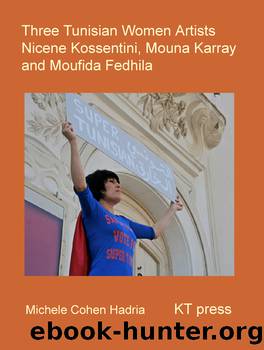Three Tunisian Women Artists by Hadria Michèle Cohen;Hayward Judith;

Author:Hadria, Michèle Cohen;Hayward, Judith; [Michele Cohen Hadria]
Language: eng
Format: epub
ISBN: 4420210
Publisher: KT press
Published: 2013-08-05T00:00:00+00:00
Mouna Karray: But everything happened a bit by chance! You met us almost by accident! Because there was no structure to represent us, no form of visibility for us. No cultural policy. Where theatre and cinema were concerned, the situation followed a certain tradition through networks, pre-existing structures that despite Ben Ali were able to retain a form of visibility. But for the visual arts, it was completely different. Moreover, producing art is a solitary pursuit. But that solitude was heightened even more for those artists who found no context to represent and support them. There was an Art School, itâs true, but no art critics, no art journals, no association to connect everything up. No art market. Tunisians themselves donât have any access to art or artists. Hence these misunderstandings faced with a work of art, especially when extremists get involved, creating that recent scandal during the La Marsa Art Spring event.22
Michèle Cohen Hadria: My understanding of this is that the instigation of the Salafists, the Tunisian public got angry about the supposed âattacks on the sacredâ in several paintings...
Mouna Karray: Those accusations made against painters and photographers also showed the extent to which the interpretation of a work by the public was totally at odds with that of the artists. Today thereâs a huge gap between the artist and the Tunisian population! The Ministry of Culture has never created the slightest structure to prepare the public.
Michèle Cohen Hadria: Itâs true that art canât be open for instant interpretation. It has its codes, like those of a musical score. All art requires a certain historical preparation for it to be understood...
Mouna Karray: And we would also have to define what the sacred is, what sacrilege is. And also to think about protecting artists. Because if Tunisian artists were marginalised yesterday, today theyâre in danger.
Michèle Cohen Hadria: The Muslim world didnât have any separation comparable to that of Church and State, as in France for example, despite the endeavours of Arab reformist thinkers in the nineteenth century, in particular during the Nahda (which means the awakening). Itâs also true that, to the extent that the Koran in early days had no option other than to present itself as a judicial controller and an instrument to implement jurisprudence, the definition of the status of the individual has been governed by religious law, as has the status of genders. However, I know through reading the Egyptian intellectual Mansour Fahmi that Islam was originally egalitarian, in particular regarding the status of women. But interpretations have intervened over the course of history (re)producing patriarchal vicissitudes. Things have become very intricate, indeed almost inextricable, at least to my eyes, between these two statuses, civil and religious. One of the works at that so decried exhibition at La Marsa was attempting to put a womanâs private space and the fundamentalist sphere in view of one another, I think...
Mouna Karray: The real question is that of women and their bodies. But that fundamentalism has nothing to do with the Koran.
Download
This site does not store any files on its server. We only index and link to content provided by other sites. Please contact the content providers to delete copyright contents if any and email us, we'll remove relevant links or contents immediately.
Technical Art History by Jehane Ragai(456)
Art, Science, and the Natural World in the Ancient Mediterranean, 300 BC to AD 100 by JOSHUA J. THOMAS(410)
Graphic Culture by Lerner Jillian;(397)
The Slavic Myths by Noah Charney(370)
Pollak's Arm by Hans von Trotha(340)
Simply Artificial Intelligence by Dorling Kindersley(339)
Treasuring the Gaze by Hanneke Grootenboer(337)
Sketchbook Confidential: Secrets from the private sketches of over 40 master artists by Editors of North Light Books(337)
The Art of Portrait Drawing by Cuong i(331)
Drawing for the Soul by Zoë Ingram(328)
Drawing Landscapes by Barrington Barber(320)
Mountain Manâs Field Guide to Grammar by Gary Spina(313)
The Art of Painting Sea Life in Watercolor by Maury Aaseng Hailey E. Herrera Louise De Masi and Ronald Pratt(310)
Portrait of a Woman by Bridget Quinn(300)
Anatomy for the Artist by Jennifer Crouch(294)
A text-book of the history of painting by Van Dyke John Charles 1856-1932(288)
Preparing Dinosaurs by Wylie Caitlin Donahue;(282)
Botanical Illustration by Valerie Price(280)
Egyptian art by Jean Capart(277)
